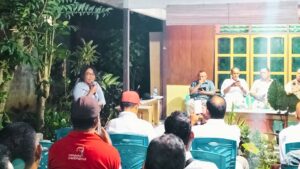Made Darundya, the Sasak Puppet Master was speechless. For a minute he was stunned. Then he hugged Jayengrana and Munigarim – two hundred years of age puppet characters – belonging to Muhammad.
Tears ran down his face. He imagined hugging his grandfather, Nengah Gowang – a famous and legendary Sasak Puppet Master in Lombok Island. Darundya released his emotion.
“He was really thrilled when I showed him two of his grandfather’s puppet legacy,” Muhammad said in his residence at Gunung Agung Village, Pemepek, Central Lombok last April. Muhammad is also a Puppet Master
Those two main characters of Sasak Puppet that had made Darundya shed a tear were not ordinary puppets. At least for Muhammad and Darundya. Both masters held special feelings for the puppets.
Muhammad shared, those two puppets he inherited from Amaq Madim, the first generation of Puppet Master in Bonjeruk Village, Central Lombok. “Amaq Madim learned to be a Puppet Master from Nengah Gowang, Darundya’s grandfather,”
Even though served as a teacher for Amaq Madim, Nengah Gowang was mesmerized by his pupil’s skills in performing the puppet. In his hands, the dead shadow puppet appeared to be alive.
“Nengah Gowang was puzzled by the way Amaq Madim mastered the puppet so amazingly and able to make it came to live in colours,” Muhammad’s hands were trying to mimic the way Amaq Madim played the puppet.
Nengah Gowang and Amaq Madim were two Sasak Puppet Masters from different backgrounds. Nengah Gowang was a Hindu, while Amaq Madim was a Moslem. They were good friends, more like brothers. As the token of brotherhood, Nengah Gowang gave two puppets, Jayengrana and Munigarim, to Amaq Madim.
Those two puppets made Darundya cry. It was as if Muhammad and Made Darundya reliving the friendship between Nengah Gowang and Amaq Madim. The brotherhood between the two Sasak Puppet Masters in a frame of diversity.
Sasak Puppet is folklore of art entertainment that has been preserved until now in Lombok. Different from the Javanese or Balinese puppet that often plays Ramayana and Mahabharata, the source of the Sasak puppet is Serat Manak – it tells the story on the journey of Islam. Sasak puppet is widely known as a preaching media to spread Islam in Lombok.
Characters in Sasak puppet are easy to recognize, the right puppets – placed on the right-hand side of the master, are the protagonists from the Islamic kingdom led by King Jayengrana of Amir Hamzah, the uncle of Prophet Muhammad SAW – a central figure in Islam.
Meanwhile, the left puppets – on the left-hand side of the master – are the antagonists from unreligious kingdoms that fight against Jayengrana. Stories in Sasak puppet often end with the conquering of the left puppet’s kingdoms by King Jayengrana. Defeated kings will be given options to be detained or convert to Islam, following the rules of prophet Ibrahim.
“If they chose to follow the Islamic way, they will be taught to recite the Syahadat, as the mark of conversion,” Darundya said while reciting the Syahadat perfectly. This Puppet Master was born in Lombok on August 12, 1966, and he admitted that he knows The Pillars of Faith (Rukun Iman), The Pillars of Islam (Rukun Islam), and the genealogy of Islamic prophets. He even routinely fasting for a week before performing.
Even though Sasak puppet is clearly holding an Islamic missionary role, but historically there were several Hindu puppet masters performed the Serat Menak without changing the storyline. One of them was the legendary Nengah Gowang.
The presence of Gowang as a Hindu who performed an Islamic puppet story became a unique element. Gowang was famous as a puppet master who relied strongly on the path and storyline of Serat Menak. The same thing is currently carried out by his grandson, Made Darundya. “When performing, I use the guidelines and storyline. I dare not change it,” Darundya said.
A number of puppet masters met by TEMPO confirmed Darundya’s story. Nothing was changed in terms of storyline, even by Hindu puppet masters. “Those Hindu masters strongly hold the principles of the storyline,” Haji Syafwan, one of the puppet masters who is also a teacher in Sasak Puppet Mastery School.
“Actually all these Sasak people are grateful and thankful because the first ones who understand the storyline and very skillful in performing were the ones from Bali; Nengah Gowang and Jero Giyur. Nengah Gowang was even a teacher to many puppet masters in Lombok,” Syafwan said.
When we watch the Sasak puppet show, we will easily differentiate whether the master is a Moslem or a Hindu. A Moslem puppet master usually opens the show with ‘gunungan’ and the couple of Jayengrana and Munigarim. If the puppet master is a Hindu, the show will be opened with the appearance of Rurah and Kembung characters.
“When you see Rurah and Kembung at the opening, the puppet master must be a Hindu,” Made Kantun (70), one of the retired Hindu puppet masters, said. He has retired and became a handler instead.
The existence of Hindu Sasak puppet masters is warmly welcome by the people in Lombok. Not only the Moslem community, but even the Hindu community in Lombok also hired Sasak puppet show whenever they have festive events. Usually, it involves a vow to have a Sasak puppet show if a wish was granted. “I can perform a Balinese puppet show too. I would offer them, would you prefer Balinese or Sasak puppet show, and they usually chose Sasak,” Darundya said.
Not just that, in certain ceremonies, the Sasak puppet show even performed at the Hindu temple. From the log of performance belonging to his father, Darundya noticed two performances were held at Pura Penganjolan, on 7 and 8 of April 1988.
The Sasak puppet show is not only familiar among the Moslem and Hindu, but also acceptable in the Buddhist community. Amaq Wasiah (70) is a senior puppet master in Mapak Village, North Lombok who had the opportunity to perform a Sasak puppet show in a Buddhist community in Bentek, North Lombok. “They accepted it well. There was no rejection,” Amaq Wasiah said.
“Art has no religion,” Muhammad Yamin, a cultural expert in Lombok said. He explained that this Sasak puppet phenomenon as a traditional media for Islamic missionary that is widely accepted by everyone, including performed by Hindu masters.
“The role of art often serves as a bridge between two different cultural concepts, it is like general knowledge. The Hindu puppet masters apparently saw the puppet as a form of art, apart from the similarity in the theological substance between Islam and Hindu,” Yamin said.
The artistic element is larger than the religious mission, this has made Sasak puppet acceptable everywhere. “The element of art is so dominant compared to religious messages. Mission was embedded in the artistic message,” Yamin said.
Sasak puppet was evidently able to merge diversity without prejudice. An Islamic tradition in Lombok that is well-respected by the Hindu community throughout West Nusa Tenggara.
Original source: Wayang Sasak Penghormatan Terhadap Keberagaman







